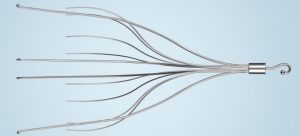IVC Filter
 IVC or inferior vena cava filters have been used in the medical field as early as 1968, and their purpose is to prevent blood clots from flowing from the vein up into the heart or lungs of a patient, which could cause serious injury or death. IVC filters look like a tiny wire funnel that are inserted into the major cardiac veins to physically break-up clots that are moving through the circulatory system prior to them reaching the heart. Because a metal object is inserted into a vein, there is potential that it can become dislodged and do even more damage than the clot it was inserted to destroy. IVC filters are not the first line of defense and are usually treated as a last resort and only used when anticoagulants or other attempts to reduce blood clotting have failed. More than 250,000 filters have been inserted into patients.
IVC or inferior vena cava filters have been used in the medical field as early as 1968, and their purpose is to prevent blood clots from flowing from the vein up into the heart or lungs of a patient, which could cause serious injury or death. IVC filters look like a tiny wire funnel that are inserted into the major cardiac veins to physically break-up clots that are moving through the circulatory system prior to them reaching the heart. Because a metal object is inserted into a vein, there is potential that it can become dislodged and do even more damage than the clot it was inserted to destroy. IVC filters are not the first line of defense and are usually treated as a last resort and only used when anticoagulants or other attempts to reduce blood clotting have failed. More than 250,000 filters have been inserted into patients.
C.R. Bard, founded in 1907 and based out of Murray Hill, New Jersey is a medical products corporation that specializes in manufacturing and marketing potentially life-saving medical technologies in the vascular, urology, oncology, and surgical fields. While Bard manufactures many different medical products, one of their products has been in the news quite a bit over the past year or so—their IVC filter.
C.R. Bard began manufacturing and selling their G2 IVC filter system in 2005 after it was approved by the FDA. While they marketed the G2 IVC filter system as being less prone to moving or breakage, studies have shown that Bard’s G2 filter actually had a higher risk of adverse effects (including death) than its competitor’s filters, and the FDA disclosed in 2010 that removable IVC filters like Bard’s G2 filter were associated with hundreds of adverse events which included movement of the filter, breakage of the filter, and even an embolism in some patients.
Cook Medical also makes a removable IVC filter that is the subject of substantial scrutiny and lawsuits.
In 2014, the FDA issued an advisory report in an attempt to remind physicians that removable IVC filters should be removed within 29 to 54 days after they are implanted in the patient to avoid complications. This report probably came as a result of some 2013 studies published in the Journal of the American Medical Association (JAMA) which suggested that the rate of successful IVC filter removal was low.
As of 2015, there have been hundreds of adverse effects reported arising out of the use of Bard’s G2 IVC filter, and at least 27 deaths associated with its use. If you or a loved one suffered complications, injury or death as a result of an IVC filter, contact the Merman Law Firm immediately for compassionate representation.


